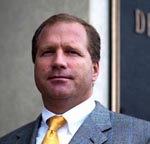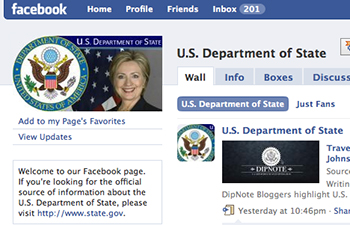The Defense Department’s new head of public affairs says there is no more powerful communication tool in reaching supporters and critics alike then with a personally delivered message.
What’s the suggestion? Social media technologies like Facebook, MySpace and Twitter must be thoroughly engaged by civilian and military personnel at DoD in a new era of personal communication. That’s what Price Floyd, the Pentagon’s new principal deputy assistant secretary of public affairs, told me in a recent phone interview.

“There is no more powerful voice than a young officer or a young enlisted man or woman talking about what it is like to serve their country,” said Floyd. “That’s the most powerful communicator we can have. Likewise, if we can reach out to our people overseas…posted at bases around the world to discuss policies that we may have or misunderstandings that may arise, those people need to communicate in the ways the people communicate today.”
Included in the DoD ranks already using social media are Joint Chiefs of Staff Chairman Adm. Mike Mullen (who has 5,652 Twitter followers and 2,552 Facebook fans) and Commander Adm. James, head of European Command (who has 3,515 Twitter followers and 906 Facebook fans), among others.
“There are thousands of social networking sites that people in the military or civilians at DoD use and take part in everyday,” said Floyd, who has 909 Twitter followers and 4,756 Facebook fans.
Banning Social Media Sites
Despite what appears to be a Pentagon embrace of tweeting and status updates, recent reports suggest the military is planning a widespread ban on social media websites.
Leading the charge is the Marine Corps which announced August 9 a ban on social networking sites on the Defense Department’s unclassified network, the enterprise network (NIRRNET), citing security concerns about cyber-threats such as hackers.
Additionally, recent reports from Noah Shachtman at Wired.com suggest that a military-wide ban on social networks may be a certainty.
Floyd acknowledges that there are security risks by allowing Pentagon staffers and soldiers in the field access to social media networks. But, he says that if releasing sensitive information on a postcard or letter is against policy, tweeting the information isn’t any different.
“We need to have continued education and training of people on these sites and remind them that just because they are on Facebook or Twitter, that operational security still matters and still needs to be followed,” Floyd said.
When asked if the Marine Corps ban on social media sites was a mistake, Floyd said that a policy is currently being crafted on how Defense Department personnel should approach social media and other new technologies. The recommendations from the report are expected to become a department-wide policy by mid-September which could mean the Marine Corps ban may be lifted.
“There should be a consistent policy implemented across the board so you don’t have the kind of haphazard use of these technologies that we currently have,” Floyd said.
Secretary Gates’ apparent push for better communication is part of an effort to encourage feedback not only from the American public and around the world, but also from within the Pentagon. Floyd’s hope is that use of social media networks could even have an effect on DoD policy.
The Godmother of Innovation
Across the beltway at Foggy Bottom, Secretary of State Hillary Clinton has all her lines in the social media waters. The brains behind Clinton’s aggressive push for innovation at State is Alec Ross who has been appointed the senior adviser on innovation.
Ross, who worked on then-Senator Barack Obama’s campaign helping to craft tech policy, is pioneering what he calls 21st century statecraft at the State Department.
Essentially the idea behind 21st century statecraft is expanding the traditional dominion of diplomacy from government to government to also include a more citizen-centered form of engagement such Obama’s speech in Cairo where he was speaking not just to Arab governments but directly to Muslim people.
Ross calls Secretary Clinton the “godmother of technology and 21st century statecraft.” He says social media is a messy place and that with modern technologies you don’t know what’s going to work, but that taking risks is essential to meeting diplomatic and development goals.

“The larger issues and more important issues in my mind are to commit to using social media tools,” Ross said in a phone interview. “Not as something that’s cute or has a gee-whiz factor to it, but as an everyday instrument in our diplomatic practice.”
The State Department appears to be engaging with Web 2.0 and is neck deep in the social media world with more than 13,000 Facebook fans as well as more than 7,500 Twitter followers. For Secretary Clinton’s current trip through Africa, you can send her a direct text message with questions or comments that are being answered by Clinton.
Losing Command and Control
As with the Defense Department, State is attempting to empower staffers and diplomats to use new web-based innovations. This comes with risks.
The recent reports about 27-year-old State Department official Jared Cohen emailing Twitter co-founder, Jack Dorsey asking for a delay of Twitter’s scheduled maintenance over concerns that it might silence protests in Iran ignited a small controversy.
Ross says that engaging social media involves quick decision-making and that you have to trust people.
“The kind of command and control that we were able insist on during the Cold War cannot and does not exist in the 21st century,” Ross said. “Where analyzing a very small number of resources and controlling messaging toward a very small number of media sources; point-in-fact there are millions of consumers and media outlets across multiple platforms…You’ve got to trust in the State Dept. professionals who are here to do their job rather than just taking instructions and sort of zombie-like motions of saying exactly that which was dictated to them from on high.”
While the military is contemplating a ban on social media and working out a policy to guide an overall DoD approach, Ross is pushing an approach at State that has more to do with coaching. He says that any policy set in stone pertaining to new technologies like social media will quickly become irrelevant and out of date.
“If you just say from on-high ‘thou shalt A-B-C when using technology and social media,’ you’re going to be irrelevant and out of date in about 30 minutes,” Ross said.
Steven Davy is a freelance journalist, and freelance radio reporter/producer. He regularly covers the defense industry and security related issues for UPI. Additionally he hosts a current affairs news magazine radio show called the Nonchalant Café Hour which broadcasts live in Kalamazoo, Mich. Steven is a second year graduate student at Michigan State University in the School of Journalism. His research has covered news media bias and framing issues, censorship during war, urban revitalization, renewable energy and climate change.


Another compelling DOD organization to make note of is U.S. Army Public Affairs.
http://www.facebook.com/usarmy (46,000+ fans)
http://www.twitter.com/usarmy (13,000+ followers)
http://www.flickr.com/soldiersmediacenter
These are only a few examples of how the Army is engaging in online social media environments in very innovative and effective ways. What’s of equal significance is the manner in which the Army seems to be taking a holistic approach to social media engagement. Strong connections are consistently made between these “external” environments and their official Web site at http://www.army.mil.